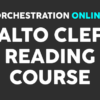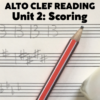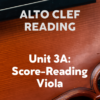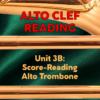(originally posted Dec. 21, 2016 on Patreon)
Early this morning, iconic Star Wars actress and writer Carrie Fisher passed away from complications following a heart attack. Now, a member of the Orchestration Online community might fairly ask why I should take this opportunity to commemorate her, as she wasn’t a composer or musician. The reason is simple – for a lot of composers, she was an inspiration and a strong part of the culture in which they grew up. I’ve been receiving messages all morning from composers who are shattered at the news. All I can say is that she seems to have been the kind of person who’d prefer to be celebrated than mourned; to have everyone look at her life and share what it meant to them, rather than descend into dolour.
Fisher once said “I don’t want life to IMITATE art. I want life to BE art.” That is a very simple way of expressing a more complex topic that I’ve been stressing recently here in the community: that you should see art as a way of finding out who you are, and growing with each successive act into a person that you never really expected or understood. Wise words, Carrie.
In another way, I know of many artistic women to whom Carrie Fisher’s achievement was a guide and inspiration to their own eventual paths. Her presence in the Star Wars films said that the future will be a place where women are important and interesting people – not just love interests and rescue objects. I will leave it to them to share their perspectives – but I’ll just say personally that her onscreen personality, and her later activities as a writer, all figure heavily in helping me to respect the contribution of creative women as my colleagues.
There’s one last way that Carrie Fisher/Leia Organa helped to change the world, and that was in inspiring those around her who worked to capture and immortalise her work. Of course her producer and director George Lucas figures heavily in this, along with his crew and her fellow actors. But for us as orchestral composers, the effect she had on John Williams is most significant. Williams is well-known for using his emotional responses to characters to bring them to life. He’s admitted to “falling in love” (creatively, ahem) with both Daisy Ridley and Carrie Fisher when their Star Wars characters were first brought into his work as film composer, and to have expressed that sense of affection with two of his most memorable themes. I’ve already analysed the orchestration for “Rey’s Theme” upon the release of Star Wars: The Force Awakens. Now, in memory of Carrie Fisher, I’ll take the time today to write about “Leia’s Theme” from the original Star Wars release of 1977. Please refer to the embedded video above for reference.
The soundtrack cut starts with two little wind intros, first flute and then oboe, in front of delicately minimal strings and harp. Notice that even these two throwaway lines are right in the sweet spots of their instruments; flute A5-D6, and oboe D5-G5. So is the opening horn line that follows. I want to underline here that part of Williams’ easy virtuosity as an orchestrator is his use of ideal registers in many key passages such as this. As you listen to the horn slowly rise throughout this passage, let your ears go behind the solo to grasp the slowly pulsing high pianissimo string accompaniment. That helps to put the horn spatially in context – without it, or with more emphatic support, the magic here would be absent. Notice the high points of the horn arcs – the highest at a concert C#5, or written G#5. This is no problem for any competent player, but listen to how the soloist in this video makes it sound easy, and not “high.” There’s no stress up there, just light. That is a bit rarer.
What follows is a bit of Villa-Lobos-influenced scoring, with English horn and bassoon playing little contrary motion riffs away from each other. I can’t think of any clearer demonstration that the two instruments are from different families than this, despite their similar tone production and reeds (which caused Adler to categorise them in the same family). Note how the bassoonist is using almost no vibrato whatsoever, which also helps differentiate the timbres. Solo flute enters and reiterates the horn solo, largely note-for-note. Once again, examine the register: starting from the lowest note of its middle register, A4, and then slowly up from breathiness to clarity as it approaches the sweet spot again. I like the way the passage ends with the oboe and flute in octaves – a slightly unbearable sound, perhaps illustrating that Leia’s character isn’t just some powder puff. The counterpoint from horn below completes the sense of expansion of character. But note that the background strings aren’t playing unmeasured single tremolos, but fingered tremolos alternating between two pitches. This gives the texture a deep shuddering quality rather than tensely trembling.
Just a brief note about the harp here and in other places in the cut – Williams is scoring middle range rather than high. Developing composers tend to fall in love with the high plinking sound of the harp, and neglect the more thrumming, dewy central and lower pitches. If you really listen to the harp scoring, you can see just how effective that register is, both emotionally and in building a texture.
That dewy plucking is especially important in the passage that follows, as Williams draws once again on Villa-Lobos with a lovely, imaginative flute solo that fully inhabits its upper range, displaying its technical capacity in expressive ways. Meanwhile, offbeat horns pulse below along to the harp’s gentle strum. This might seem like an isolated character moment, but Williams is actually just setting up the next passage, deepening the complexity of Leia’s character. Listen to how the soaring strings take everything that was lyrical about original theme, and add determination, inner struggle, and defiance. The boys came to rescue a princess-in-distress, and instead found a steely-willed, wise-cracking leader of a rebellion. To really show you everything in detail, I’d have to have diagram the original score, and I respect the composer too much to do that without permission. But you don’t really need that: just use your ear to hear how the first horn counterpoints the string octaves with little bits of inverted and subverted theme from below; while the winds dance around above, sharply commenting here and there, until the heavy brass eventually emerge to put more teeth under the string’s growingly frantic expostulations. I like how those strings eventually reach a high C7 – but they approach that high note after having gone all over the map elsewhere, so it really counts instead of being needlessly hysterical.
This muscular passage gives way to a simple, stark trio of flute, oboe, and clarinet, answered by a violin solo that ascends to truly Elysian heights, ending in an artificial harmonic E7, supported by a cool, radiant final chord that’s straight out of Rimsky-Korsakov’s Scheherazade.
At the time this was scored, Williams worked with the orchestrator Herbert Spencer, along with a few others. But it’s important to underline that the choice of soloists, the character of the accompaniments, and even the scoring details in many places were worked out by Williams in advance, leaving the orchestrators the job of scoring it out for the players and doing the busywork of filling in textures and so on. The music that you hear in this cut would surely have been composed specifically by Williams to fit the registers of the instruments involved to their best coloristic and expressive effect. That is one area where I’d be loth to give his assistants too much credit. Since he lost Spencer, apparently Williams has become even more exacting in his sketches, leaving any competent assistant little to do except for what is needed to be done in the right way.
At any rate, especially in regard to that penultimate episode with string octave, I feel that Williams really captured the personality of not only the character on the screen, but the actress beneath it. We come away more focused on the character and its potential to go in many different directions, than simply a general impression of fairy-tale princess. But such an artistic response would have been impossible without someone of character to evoke it. Ponder on that the next time you face a piece of footage, and have to bring a character to life, along with his or her backstory and place in the narrative thread. The brighter the candle, the easier it is to read the instructions from your muse.
RIP Carrie Fisher, 1956-2016









